Sword bean
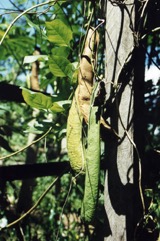
A tropical plant. It requires a tropical climate. Temperatures of 20-30°C suit it well and it grows from sea level to about 1000 m altitude in equatorial zones. They are drought and salt resistant. They can grow on lowland tropical nutrient depleted soils. They can grow on soils with pH from 4.5-7.0. They can tolerate some shade. In Yunnan.
Also known as:
Abai, Abbo, Alad, Baikang, Baikng, Bara sem, Bon shim, Carabanz, Chemma kaaya, Dau-rua, Frijol cafe, Frijol de machete, Ghevada, Habas, Jangli Sem, Jungli abhui, Kacang parasman, Kacang polong, Kachang hantu, Kachang nyonya, Kachang parang, Kaos parasman, Kara pedang, Kara wedung, Koas bakol, Lal kadsumbal, Madezo, Magtambokau, Makhan shim, Moushim, Naga sem, Nam-nawbaw, Namtaipee, Nkasa, Pe-dalet, Pe-dama, Pe-damouk, Pe-det, Pe-gale, Pe-naung-ni, Rar bu-shot kwen-e, Sanndaek triehs, Segapu thambattai, Sem, Shembi avare, Tarvardi, Thampattai, Thua phraa, Tioeuhs, Tua pra, Tumbekai, Yerra tamma
Synonyms
- Canavalia ensiformis (L.) DC. var. alba Makino
- Canavalia ensiformis auct. non (L.) DC.
- Canavalia ensiformis (L.) DC. var. gladiata (Jacq.) Kuntze
- Canavalia gladiata (Jacq.) DC. var. alba (Makino) Hisauti
- Canavalia gladiata (Jacq.) DC. var. machaeroides DC.
- Canavalia gladiolata J. D. Sauer
- Canavalia incurva (Thunb.) DC.
- Canavalia incurva Thouars
- Canavalia loureirii G. Don.
- Canavalia machaeroides (DC.) Steudel
- Canavalia maxima Thouars
- Dolichos gladiatus Jacq.
- Dolichos incurvus Thunb.
- Malocchia gladiata (Jacq.) Savi
Edible Portion
- Seeds, Leaves, Pods, Spice, Vegetable
Where does Sword bean grow?
Found in: Africa, Angola, Argentina, Asia, Australia, Bangladesh, Benin, Brazil, Burundi, Cambodia, Central Africa, Central America, China, Congo DR, Cuba, East Africa, Fiji, Ghana, Guadeloupe, Guatemala, Guianas, Haiti, Hawaii, Honduras, India, Indochina, Indonesia, Jamaica, Japan, Korea, Laos, Madagascar, Malaysia, Mauritius, Mexico, Mozambique, Myanmar, Nigeria, North America, Northeastern India, Pacific, Panama, Papua New Guinea, PNG, Paraguay, Philippines, SE Asia, Seychelles, Singapore, Solomon Islands, South Africa, Southern Africa, South America, Sri Lanka, Suriname, Taiwan, Tanzania, Thailand, United States, Vietnam, West Africa, West Indies, Zambia, Zimbabwe
Notes: There are about 50 Canavalia species.
Status: It is a commercially cultivated vegetable. Pods are sold in local markets. Only occasionally grown in Papua New Guinea.
Growing Sword bean
Cultivation: They are grown from seeds. Seeds germinate readily and the plant is relatively fast growing. Seeds can be sown 5 cm deep. Plants should be 60-70 cm apart. Climbing types need support. Often natural supports such as trees, walls and fences are used in backyard production. For large scale production 25-40 kg/ha of seed are needed.
Edible Uses: Young pods are cooked and eaten. Seeds can be cooked and eaten, but the water should be changed and they should be well boiled. They are also fermented. The seeds can be toasted and ground and used as a coffee substitute. The leaves are blanched and eaten. CAUTION The seeds can be poisonous due to hydrocyanic acid and saponin. Cooking will remove these.
Production: Green seeds/pods are produced in 3-4 months and mature seeds in 5-10 months. Seed yields of 700-900 kg/ha are possible. Green pods are hand picked when 10-15 cm long before they swell and become fibrous.
Nutrition Info
per 100g edible portion| Edible Part | Energy (kcal) | Protein (g) | Iron (mg) | Vitamin A (ug) | Vitamin c (mg) | Zinc (mg) | % Water |
|---|---|---|---|---|---|---|---|
| Seeds | 319 | 27.1 | - | - | - | - | 15 |
| Fresh Pods | 34 | 2.8 | - | - | - | - | 89 |
| Leaves | - | - | - | - | - | - |
Sword bean Photos

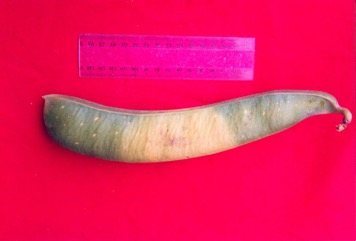
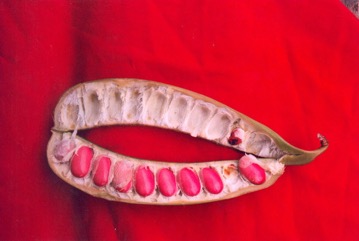
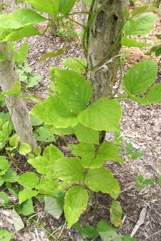
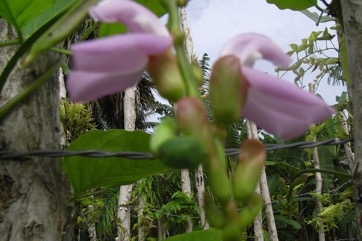
References
Sword bean references Canavalia gladiata
Ambasta S.P. (Ed.), 2000, The Useful Plants of India. CSIR India. p 101
Arinathan, V., et al, 2007, Wild edibles used by Palliyars of the western Ghats, Tamil Nadu. Indian Journal of Traditional Knowledge. 6(1) pp 163-168
BARC, 2016, State of Biodiversity for Food and Agriculture in Bangladesh. Bangladesh Agricultural Research Council.
Bircher, A. G. & Bircher, W. H., 2000, Encyclopedia of Fruit Trees and Edible Flowering Plants in Egypt and the Subtropics. AUC Press. p 80
Biswas, S. C., et al, 2018, Diversity of wild edible minor fruits used by the ethnic communities of Tripura, India. Indian Journal of Traditional Knowledge. Vol 17(2), April 2018, pp 282-289
Bosch, C.H., 2004. Canavalia gladiata (Jacq.) DC. [Internet] Record from Protabase. Grubben, G.J.H. & Denton, O.A. (Editors). PROTA (Plant Resources of Tropical Africa), Wageningen, Netherlands. < http://database.prota.org/search.htm>. Accessed 14 October 2009.
Brown,
Burkill, H. M., 1985, The useful plants of west tropical Africa, Vol. 3. Kew.
Burkill, I.H., 1966, A Dictionary of the Economic Products of the Malay Peninsula. Ministry of Agriculture and Cooperatives, Kuala Lumpur, Malaysia. Vol 1 (A-H) p 438.
Cobley, L.S. (rev. Steele, W.M.) 2nd Ed., 1976, An Introduction to the Botany of Tropical Crops. Longmans. p 102
Deb, D., et al, 2013, Wild Edible Plants and Their Utilization in Traditional Recipes of Tripura, Northeast India. Advances in Biological Research 7(5):203-211
Duke, J. A., 1981. Handbook of legumes of world economic importance. Plenum Press, New York. 345pp
Facciola, S., 1998, Cornucopia 2: a Source Book of Edible Plants. Kampong Publications, p 103
Fowler, D. G., 2007, Zambian Plants: Their Vernacular Names and Uses. Kew. p 36
French, B.R., 1986, Food Plants of Papua New Guinea, A Compendium. Asia Pacific Science Foundation p 44
French, B.R., 2010, Food Plants of Solomon Islands. A Compendium. Food Plants International Inc. p 58
Grubben, G. J. H. and Denton, O. A. (eds), 2004, Plant Resources of Tropical Africa 2. Vegetables. PROTA, Wageningen, Netherlands. p 151
Hani Medicine of Xishuangbanna, 1999, p 511
Henty, E.E., 1980, Harmful Plants in Papua New Guinea. Botany Bulletin No 12. Division Botany, Lae, Papua New Guinea. p 79
Hossain, U. & Rahman, A., 2018, Study and quantitative analysis of wild vegetable floral diversity available in Barisal district, Bangladesh. Asian J. Med. Biol. Res. 2018, 4 (4), 362-371
Hu, Shiu-ying, 2005, Food Plants of China. The Chinese University Press. p 469
ILDIS Legumes of the World http:www:ildis.org/Legume/Web
Jacquat, C., 1990, Plants from the Markets of Thailand. D.K. Book House p 47
Jadhav, R., et al, 2015, Forest Foods of Northern Western Ghats: Mode of Consumption, Nutrition and Availability. Asian Agri-History Vol. 19, No. 4: 293-317
Japanese International Research Centre for Agricultural Science www.jircas.affrc.go.jp/project/value_addition/Vegetables
Jardin, C., 1970, List of Foods Used In Africa, FAO Nutrition Information Document Series No 2.p 25, 62
Kays, S. J., and Dias, J. C. S., 1995, Common Names of Commercially Cultivated Vegetables of the World in 15 languages. Economic Botany, Vol. 49, No. 2, pp. 115-152
Kiple, K.F. & Ornelas, K.C., (eds), 2000, The Cambridge World History of Food. CUP p 1864
Kuvar, S. D. & Shinde, R. D., 2019, Wild Edible Plants used by Kokni Tribe of Nasik District, Maharashtra. Journal of Global Biosciences. Volume 8, Number 2, 2019, pp. 5936-5945
Latham, P., 2004, Useful Plants of Bas-Congo province. Salvation Army & DFID p 67
Lautenschläger, T., et al, 2018, First large-scale ethnobotanical survey in the province of Uíge, northern Angola. Journal of Ethnobiology and Ethnomedicine (2018) 14:51
Lazarides, M. & Hince, B., 1993, Handbook of Economic Plants of Australia, CSIRO. p 46
Macmillan, H.F. (Revised Barlow, H.S., et al) 1991, Tropical Planting and Gardening. Sixth edition. Malayan Nature Society. Kuala Lumpur. p 322
Medhi, P. & Borthakur, S. K., 2012, Phytoresources from North Cachur Hills of Assam -3: Edible plants sold at Hflong market. Indian Journal or Natural Products and Resources. 3(1) pp 84-109
Medhi, P. & Borthakur, S. K., 2013, Wild edible plants sold by the Zeme Nagas at the makeshift market of Mahur, Dima Hasao district of Assam. Pleione 7(1): 84 - 93. 2013
Medhi, P., Sarma, A and Borthakur, S. K., 2014, Wild edible plants from the Dima Hasao district of Assam, India. Pleione 8(1): 133-148
Miguel, E., et al, 1989, A checklist of the cultivated plants of Cuba. Kulturpflanze 37. 1989, 211-357
Nyadanu, D., et al, 2015, Agro-biodiversity and challenges of on-farm conservation: the case of plant genetic resources of neglected and underutilized crop species in Ghana. Genet. Resourc. Crop Evol. 62(7):
Pham-Hoang Ho, 1999, An Illustrated Flora of Vietnam. Nha Xuat Ban Tre. p 944
Phon, P., 2000, Plants used in Cambodia. © Pauline Dy Phon, Phnom Penh, Cambodia. p 128
Plants of Haiti Smithsonian Institute http://botany.si.edu/antilles/West Indies
Prodr. 2:404. 1825
PROSEA handbook Volume 13 Spices. p 275
Purseglove, J.W., 1968, Tropical Crops:Dicotyledons, Longmans. p 245
Reddy, B. M., 2012, Wild edible plants of Chandrapur district, Maharashtra, India. Indian Journal of Natural Products and Resources. 3(1) pp 110-117
Reis, S. V. and Lipp, F. L., 1982, New Plant Sources for Drugs and Foods from the New York Botanical Garden herbarium. Harvard. p 130
Ruiters-Welcome, A. K., 2019, Food plants of southern Africa. Ph.D. thesis. Univ. of Johannesburg p 56
Sarvalingam, A., et al, 2014, Wild edible plant resources used by the Irulas of the Maruthamalai Hills, Southern Western Ghats, Coimbatore, Tamil Nadu. Indian Journal of Natural Products and Resources 5(2):198-201
Shah, G.L. et al, 1981, An account of the Ethnobotany of Saurashtra in Gujarat State (India). J. Econ. Tax. Bot. Vol 2 pp 173-182
Siemonsma, J. S. and Piluek, K. (Eds), 1994, Plant Resources of South-East Asia No. 8 Vegetables. Prosea Foundation, Bogor, Indonesia, p 134
Singh, V. and Singh, P., 1981, Edible Wild Plants of Eastern Rajasthan. J. Econ. Tax. Bot. Vol 2 pp 197-207
Terra, G.J.A., 1973, Tropical Vegetables. Communication 54e Royal Tropical Institute, Amsterdam, p 34
Terrell et al. 1986. Agric. Handb. no. 505.
Tindall, H.D., & Williams, J.T., 1977, Tropical Vegetables and their Genetic Resources, International Board for Plant Genetic Resources, Rome, p 76
Tindall, H.D., 1983, Vegetables in the Tropics, Macmillan p 259
USDA, ARS, National Genetic Resources Program. Germplasm Resources Information Network - (GRIN). [Online Database] National Germplasm Resources Laboratory, Beltsville, Maryland. Available: www.ars-grin.gov/cgi-bin/npgs/html/econ.pl (10 April 2000)
van Wyk, B., 2005, Food Plants of the World. An illustrated guide. Timber press. p 113
van Wyk, Ben-Erik, 2019, The diversity and multiple uses of southern African legumes. Australian Systematic Botany, 2019, 32, 519–546
Verdcourt, B., 1979, Manual of New Guinea Legumes. Botany Bulletin No 11, Division of Botany, Lae, Papua New Guinea. p 474
Wilson, J.M. & Witcombe, J.R., Crops for Arid lands, in Wickens, G.E., Goodin, J.R., and Field, D.V.,(Eds.) 1985, Plants for Arid Lands. Unwin Hyman, London, p 45
World Checklist of Useful Plant Species 2020. Royal Botanic Gardens, Kew